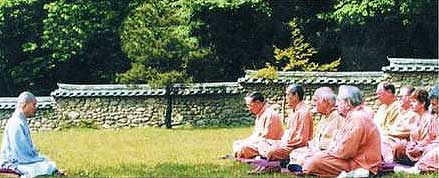
|
|
|
Home Asia Pacific North Asia S/N Korea Temple Stay Spiritual sojournThe Sun, June 30, 2005
Temple stays have become a popular holiday experience for tourists in South Korea
The idea goes back to the year when South Korea co-hosted the 2002 World Cup. Since the hotels were fully booked, the government asked the monks to make additional beds available for fans at their temples. The idea soon caught on. "Success is coming slowly but it is coming," says Hyun-Yeong-yoong of the Temple Stay Division. Last year alone, some 32,000 Koreans and 3,000 foreign visitors made use of the programme. Every temple is different. The Golgulsa Temple is a cave temple set up during the Silla Kingdom. Those staying at this temple wake up to the sounds of mountain birds at 4am and take part in morning rites and meditation. After that, they take an early morning walk along a forest path, followed by a monk breakfast. After the seonmudo or meditation training, participants "repent for their idle lives" by practising the ritual of the 108 bows, followed by tea with the teacher, usually a monk, and a chat with the other participants. After lunch, they will engage in light labour tasks such as handicraft or swee ping the floor with the monks. After dinner, there is an evening service, followed by more seonmudo training. The Jagwangsa Temple, meanwhile, operates temple stays mainly for foreigners but there are also some programmes for students during the summer and winter vacations. The Beomeosa Temple in the far north of the country with its elaborately-designed buildings and welldecorated prayer rooms fits the typical image of a Buddhist temple. The Silleuksa from the 13th century, on the other hand, has much to offer in its monks' daily ritual. While some monasteries are active with more than 100 monks, others only have a handful. Sometimes, the room at the temple or monastery is just an empty cell with no bed, cupboard or table; other times, it is a large dormitory with sliding doors. A typical 24-hour temple stay starts on a Saturday afternoon and includes a bell ritual with dharma drums, rhythmical sweeping with brooms, liturgical songs, meditation at sunrise, tea ceremony and repeated kneeling for prayers. Each visitor is given a flyer with the rules written down. "Don't wear any colourful clothing in the temple" and "Don't act individually". After the first introduction comes the first challenge. "We will now make some lampions," monk Chang See-yong in Silleuksa tells us. The lanter ns are made from paper, shaped like a lotus flower with a candle in the middle. "The light symbolises the wisdom of the Buddha," the monk explains as the visitors start practising the handicraft. At 4am, we are awakened by the sounds of the powerful temple bells resounding at least two dozen times. Dressed in sandals and a uniform monastery dress, the sleepy group marches single file, lantern in hand across the dark monastery square. A monk hums a meditative lithurgy and asks the group to join in. Our hosts promise "perfect harmony" between nature and the teachings of Buddha. Together, we all fall to our knees 108 times, surrounded by candles, Buddha statues and the smell of incense. "Each time is for the pains of life and respect for the Buddha," the monk explains. Depending on the time of year or the ceremony, this ritual can be performed several thousand times. Social work is part of the programme. Equipped with a simple broom, both the monks and visitors sweep the dusty paths and squares in the temple complex. Apart from the prayer rituals and tea ceremony, the monks take their time to introduce the barugongyang, the typical temple meal. It is a special Buddhist method of eating. Baru means bowls containing a moderate amount, and can also be referred to as the monks' eating style which is vegetarian. "Disciplined eating helps me to find Buddha and reminds me that I am nothing special," the monk Po Mun tells us. "It is a method of showing respect to each other and that we are all equal." Every person is given four simple bowls filled with rice, soup, vegetable and water. Silence is compulsory to concentrate spiritually on the eating. While for most visitors the temple stay is just a brief experience of daily life in a monastery, others use the opportunity to talk to a monk about any problem they might have. For more information, log on to www.tour2korea.com or www.templestaykorea.com. |
 |
|
| Korean Buddhist News from BTN (Korean Language) |
|
 |
|
|
Please help keep the Buddhist Channel going |
|
| Point
your feed reader to this location |
|




